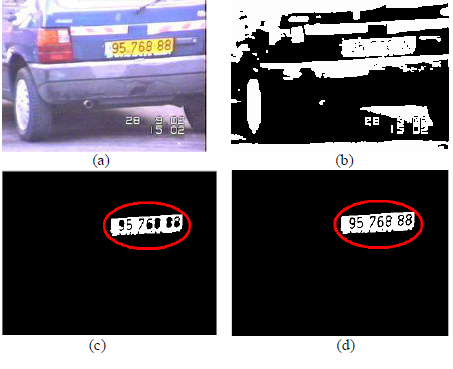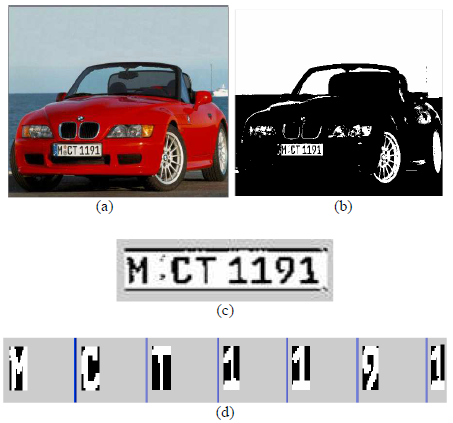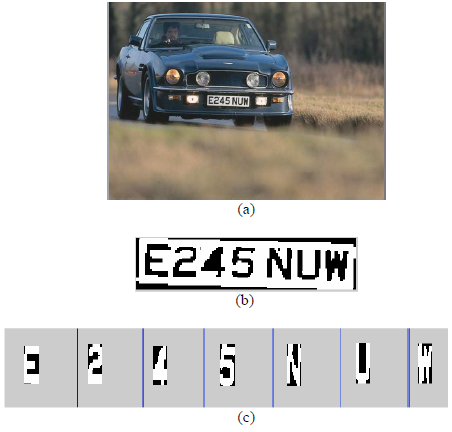ABSTRACT
An automatic and robust vehicle license plate recognition system has been developed. The proposed method uses scan line evaluation and averaging method to localize the number plate followed by a border removal mechanism combined with character mending and approximation of character height to extract the number plate characters.
Finally, a template matching approach is used to recognize the characters. A Graphical User Interface has been created and the algorithm is experimented successfully on a variety of real images, both single as well as double line plates. The sample results obtained on testing with various images are also detailed.
LITERATURE REVIEW
Plate Localization
Plate localization is done to remove the unwanted background details, and thereby focusing on to the essential details in the image. To detect the car plate, a method by applying a top-hat filter to the whole image followed by a multiscale region search has been described. Another approach has been proposed to detect the vertical edges, to extract the license plate using sobel operators.
Character Extraction
Character extraction is done by segmenting the character portions from the localized number plate. Noise contents that may also be present along with these number plate characters, makes the job a tedious one. A method has been proposed to remove the frame lines in the number plate followed by digit filtering. A method on color image segmentation, region growing and clustering methods are described.
Character Recognition
Character recognition is an essential and inevitable phase in such an application, where the system is put up to deal with nebulous or distorted characters in the license plate due to environmental hazards.
PROPOSED METHOD

Figure 1. Segmented region with three scan lines
As the image may have complex background details, number plate localization is the central issue that demands great attention. Scan line evaluation and averaging method is used here to accomplish this task. The image obtained from the sensor is filtered and binarized and the set of connected components are segmented. Following this step we measure the dimensions; height, width and area; of each of these segmented regions. Only rectangular segmented regions are taken into account.

Figure 3. (a) Original image, (b) Binarized image, (c) Localized plate region with information loss, (d) Localized plate region after restoration
To extract the characters from the localized number plate, the image obtained from the previous step is complemented. The contents in this image will either be trivial noise components or characters to be identified. A border removal mechanism followed by the approximation of character height is performed to extract the characters.

Figure 5. (a) Localized number plate with distorted character within the box, (b) Mended character, (c) Segmentation result of the distorted character (the three sections constitute to form the distorted character ‘5’)
But character breakage due to improper illumination can thwart the above mentioned procedure of character extraction. So in order to surmount this problem a character mending procedure is adopted as illustrated in figure 5. This process strengthens the white pixels in the border removed number plate by turning its adjacent left and top black pixels to white. This again is done by scanning through the image for a white pixel.
EXPERIMENTAL RESULTS

Figure 6. (a) Original image, (b) Binarized image, (c) Localized number plate, (d) Extracted character set

Figure 7. (a) Original image, (b) Localized number plate, (c) Extracted character set
The concept used for coding the system does not limit it‘s workability to any specific image format or size. The input to the system can either be a color or grayscale image. Sample results obtained on working with jpeg and bmp formats are presented here in figure 6 and figure 7. The system is designed in Matlab 7 for recognizing the number plate characters of vehicles.
CONCLUSION AND FUTURE WORK
The paper explicates on license plate recognition emphasizing a scan line evaluation method to localize the license plate and a border removal mechanism combined with character mending & character height approximation to draw out the characters from the license plate without much distortion. An effort has been taken to make the proposed method work with variety of number plates of different kind of vehicles of various countries.
The success rate on plate localization is about 93% and the success rate on character extraction is about 96%. This can be taken as a feasible result when the cost of implementation of the system is considered. This method works for those images having a number plate with the characters inscribed in a single row or in double row. The GUI provides a proper environment for the system to provide promising results with white and black background number plates.
Depending upon the application for which the system is to be used, the distance between the car plate & the camera unit is adjusted, to make it work properly. Design of the number plate must be in such a manner that, their properties like the color and reflective coatings etc, is to be within the bounds of the jurisdiction. Intricate designs, that may be present in the foreground of the plate introduces a higher dimension of complexity. This design complexity can be tackled if enough information can be obtained about the foreground designs with respect to the region where the system is deployed.
The vehicle may have any number of characters in its license plate and the system does not readily depend upon the number of characters in the plate (-even, a prior knowledge about the number of expected digits only enhances the workability-). The effectiveness of the system is directly proportional to the readability of the number plate. The system assumes that the characters inscribed in the license plate are of uniform height. Finally, adequate amount of light energy and fine weather conditions are preferred for better results.
Source: University of Kerala
Authors: Kripa Iyer
>> Automobile based Matlab Project Topics with Free Base Papers Downloads
>> Huge List of Matlab Projects with Free Source Code